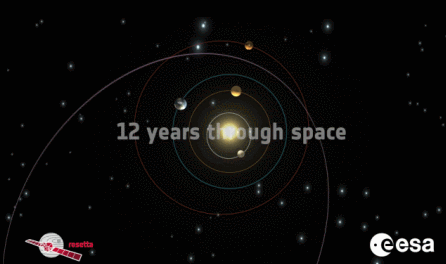Updated: November 12, 2014, 11:30 AM
DARMSTADT, Germany (AP) — The European Space Agency celebrated a cosmic touchdown Wednesday by successfully landing a spacecraft on a comet for the first time in history.
The agency said it has received a signal at 1603 GMT (11:03 a.m. EST) from the 100-kilogram (220-pound) Philae lander after it touched down on the icy surface of the comet named 67P/Churyumov-Gerasimenko.
“We definitely confirm that the lander is on the surface,” said flight director Andrea Accomazzo.
While further checks are needed to ascertain the state of the lander, the fact that it is resting on the surface of the speeding comet is already a huge success. It marks the highlight of the decade-long Rosetta mission to study comets and learn more about the origins of these celestial bodies.
The head of the European Space Agency underlined Europe’s pride in having achieved a unique first ahead of its U.S. counterpart NASA.
“We are the first to have done that, and that will stay forever,” said ESA director-general Jean-Jacques Dordain.
The landing caps a 6.4 billion-kilometer (4 billion-mile) journey begun a decade ago.

Rosetta, which was launched in 2004, had to slingshot three times around Earth and once around Mars before it could work up enough speed to chase down the comet, which it reached in August. Rosetta and the comet have been traveling in tandem ever since at 41,000 mph (66,000 kph).
The mission will also give researchers the opportunity to test the theory that comets brought organic matter and water to Earth billions of years ago, said Klim Churyumov, one of the two astronomers who discovered the comet in 1969.
___
Online:
http://new.livestream.com/ESA/cometlanding
___
Follow Frank Jordans on Twitter at http://www.twitter.com/wirereporter
___
Geir Moulson in Berlin contributed to this report.
Copyright 2014 The Associated Press. All rights reserved. This material may not be published, broadcast, rewritten or redistributed.







That’s very cool. If you’ve been feeling disappointed with your fellow humans lately for whatever reason this kind of thing can cheer you up.
And this fixes global economic problems, world hunger and rampant disease how?
Oh, that’s right…something something we need to find more fossil fuels.
We used to be able to do stuff like this, until certain idiots started asking stupid questions like when we’d find “god” with our science projects.
Stuff like this gives us a reason to live.
I can’t wait for the aliens to finally show up and find the planet deserted.
Martian anthropology textbook:
“Humanity, dissatisfied with the rate at which they were poisoning their atmosphere and causing catastrophic climate change by exploiting the rapidly dwindling supply of fossil fuels found on Earth, quickly invented ways to exploit natural resources and fossil fuels found on other heavenly bodies, extracting them and bringing them to Earth to hasten their own extinction.”